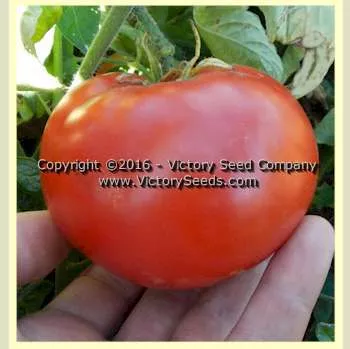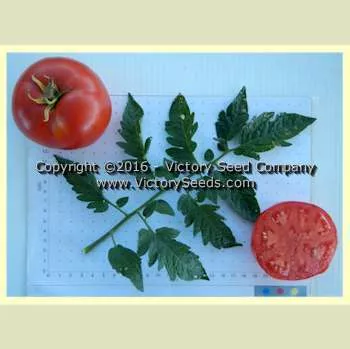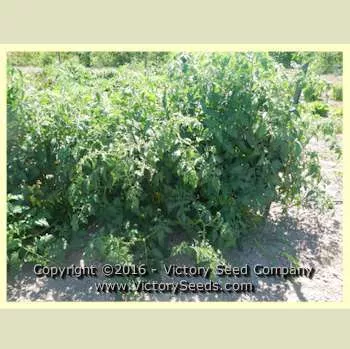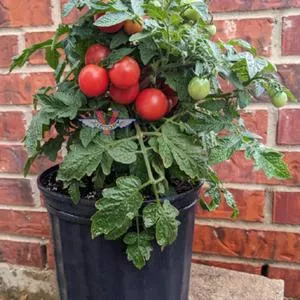



Trophy Tomato
Solanum lycopersicum
Price: $3.45
SKU: 3403821VERY IMPORTANT NOTE: This variety will be available again in early January, 2026. Please signup below to be notified when it becomes available. Click here to learn more about our seasonal products.
95 days, indeterminate - In our search for important historical varieties to preserve and protect for future gardeners to enjoy, 'Trophy' is one that has been on our "To Do List" for years. The regular leaf vines of 'Trophy' produce good amounts of medium-sized, four to twelve ounce, flattened-globe to oblate shaped red colored fruit. The fruit are also firm, solid but juicy, and mildly sweet. A good variety for processing and fresh slicing.
Beginning in 1847[3] Dr. Hand, a physician from Baltimore County, began experimenting with tomato hybridization. It is said that 'Trophy' is the result of crossing 'Large Red' with 'Early Red Smooth'[9,10] followed by twenty-three years of selecting and stabilizing. This work culminated in a distinctly new type of tomato that was of considerable merit for the time. In details now clouded by time, Dr. Hand's lawyer son, T. J. Hand[5,9] supplied seed to well-known horticulturalist, sanitary engineer, and author,[2] Col. George E. Waring, Jr.[4,5,11] of Rhode Island.
In an unusual method for introducing a new plant variety, Col. Waring, a regular contributor and advertiser in the popular "American Horticulturist" magazine, promoted a national competition. With hopes of winning a one-hundred dollar prize for raising the best 'Trophy' fruit, entrants purchased seeds for twenty-five cents each or packets of twenty seeds for five dollars.[4,5] (For a modern perspective, that five dollars in 1870 is equivalent to $87.78 in 2016.)[8]
With national exposure, people planting it all over the country, and peer reviews by famed seedsmen (see Peter Henderson's article below), by the winter of 1871, the 'Trophy' tomato had been produced in such quantities as to find it listed in many of the major seed company catalogs. American Agriculturist magazine even worked out a deal with Colonel Waring whereby subscribers would receive a packet of 'Trophy' seeds as a premium for new or renewed subscriptions.[7] It remained very popular from 1872 until about 1926[12] and is said to be involved in the parentage of most varieties introduced over the following twenty-five years.[9]
Our seed stock was grown out from seed obtained from the Seed Savers Exchange whose original sample was from USDA accession number PI 636255.
Beginning in 1847[3] Dr. Hand, a physician from Baltimore County, began experimenting with tomato hybridization. It is said that 'Trophy' is the result of crossing 'Large Red' with 'Early Red Smooth'[9,10] followed by twenty-three years of selecting and stabilizing. This work culminated in a distinctly new type of tomato that was of considerable merit for the time. In details now clouded by time, Dr. Hand's lawyer son, T. J. Hand[5,9] supplied seed to well-known horticulturalist, sanitary engineer, and author,[2] Col. George E. Waring, Jr.[4,5,11] of Rhode Island.
In an unusual method for introducing a new plant variety, Col. Waring, a regular contributor and advertiser in the popular "American Horticulturist" magazine, promoted a national competition. With hopes of winning a one-hundred dollar prize for raising the best 'Trophy' fruit, entrants purchased seeds for twenty-five cents each or packets of twenty seeds for five dollars.[4,5] (For a modern perspective, that five dollars in 1870 is equivalent to $87.78 in 2016.)[8]
With national exposure, people planting it all over the country, and peer reviews by famed seedsmen (see Peter Henderson's article below), by the winter of 1871, the 'Trophy' tomato had been produced in such quantities as to find it listed in many of the major seed company catalogs. American Agriculturist magazine even worked out a deal with Colonel Waring whereby subscribers would receive a packet of 'Trophy' seeds as a premium for new or renewed subscriptions.[7] It remained very popular from 1872 until about 1926[12] and is said to be involved in the parentage of most varieties introduced over the following twenty-five years.[9]
Our seed stock was grown out from seed obtained from the Seed Savers Exchange whose original sample was from USDA accession number PI 636255.
Fruit Color: Red
Harvest Timing: Late Season
Genetic Classification: Open Pollinated
Harvest Timing: Late Season
Genetic Classification: Open Pollinated
Sow seeds indoors (do not direct sow into the garden), using sterile seed starting mix, 6 to 8 weeks before your last expected frost date. Plant 1/4" deep, water lightly but keep moist until emergence.
Full light and cooler temps (60° to 70°) will help to prevent the seedlings from becoming too leggy. If plants become rootbound before you can safely set them into the ground, transplant them into larger pots.
Harden off plants before planting outside. Young plants are very susceptible to frost and sunburn damage. Avoid too much nitrogen. Water evenly but not in excess.
Click here to view our full tomato growing guide.
Full light and cooler temps (60° to 70°) will help to prevent the seedlings from becoming too leggy. If plants become rootbound before you can safely set them into the ground, transplant them into larger pots.
Harden off plants before planting outside. Young plants are very susceptible to frost and sunburn damage. Avoid too much nitrogen. Water evenly but not in excess.
Click here to view our full tomato growing guide.
Informational References:
- "The Vegetable Garden," by MM. Vilmorin-Andrieux, page 569, 1885.
- "George E. Waring, Jr.," Wikipedia, The Free Encyclopedia [accessed 20 September 2016].
- "Fine Tomatoes," American Agriculturist, October, 1869, page 362.
- "The 'Trophy' Tomato," by Peter Henderson, American Agriculturalist, November, 1870. (see below)
- "Tomato History in Baltimore County from the 'Love Apple'," Historical Society of Baltimore County, April 18, 2014.
- "The Tomato in America: Early History, Culture, and Cookery," by Andrew F. Smith, University of Illinois Press, 1994.
- "Special Premiums," American Agriculturist, January, 1871, page 9.
- Inflation Calculator, www.in2013dollars.com.
- "Yearbook of Agriculture for 1937," United States Department of Agriculture, page 179, 1938.
- "The Pedigree of Varieties of Lycopersicon Esculentum Mill.," G. A. Kemp, Canada Department of Agriculture, Lethbridge, Alberta, April 20, 1960.
- "Tomatoes," by H. P. Stuckey, Georgia Experiment Station, page 212, January, 1915.
- "Tomato Varieties," by Gordon Morrison, Michigan State College A.E.S., Special Bulletin 290, April 1938.
The Trophy Tomato
by Peter Henderson
by Peter Henderson
"When Col. Waring advertised this variety last spring, at 25 cents per seed, or 20 seeds for $5, few thought he would find many purchasers at such a price; but the universal interest taken in this fruit and confidence place in Mr. Waring's statements, led to the sale of seeds to a large amount of grower in all parts of the country.
I had seen the "Trophy" growing, the previous season at "Ogden Farm" [Col. Waring’s farm] at Newport, R.I., and while I felt that Mr. Waring’s description was by no means exaggerated, I declined to give him my opinion until it had been tested in other localities, where soil and climate were different. the past season I planted out a couple of dozen plants which had been started in the usual way, and tied them to stakes, Under the same conditions I planted the "New-York Market," and "Rising Sun," the varieties we considered the best and earliest of last year's experiment. In earliness, the "Trophy" had no perceptible advantage over the other two; (and by the way I think we have reach the farthest point we are likely to attain in this particular,) but in size, smoothness, and beauty of coloring, as well as in solidity and flavor, it certainly exceeded them. So that taking it all and all, I believe it to be thus far unexcelled, whether grown for private use or market purposes. This opinion I find very generally concurred in, in all sections of the country wherever it has been submitted to a trial test others. The seeds will this year be disseminated everywhere at reasonable rates, but only yet is small quantities, as the stock is yet too limited to be sold except by the paper."[4]
Customer Reviews:
Do you have experience with this one? 📝 📣 Write a review!
No reviews have been posted yet.








